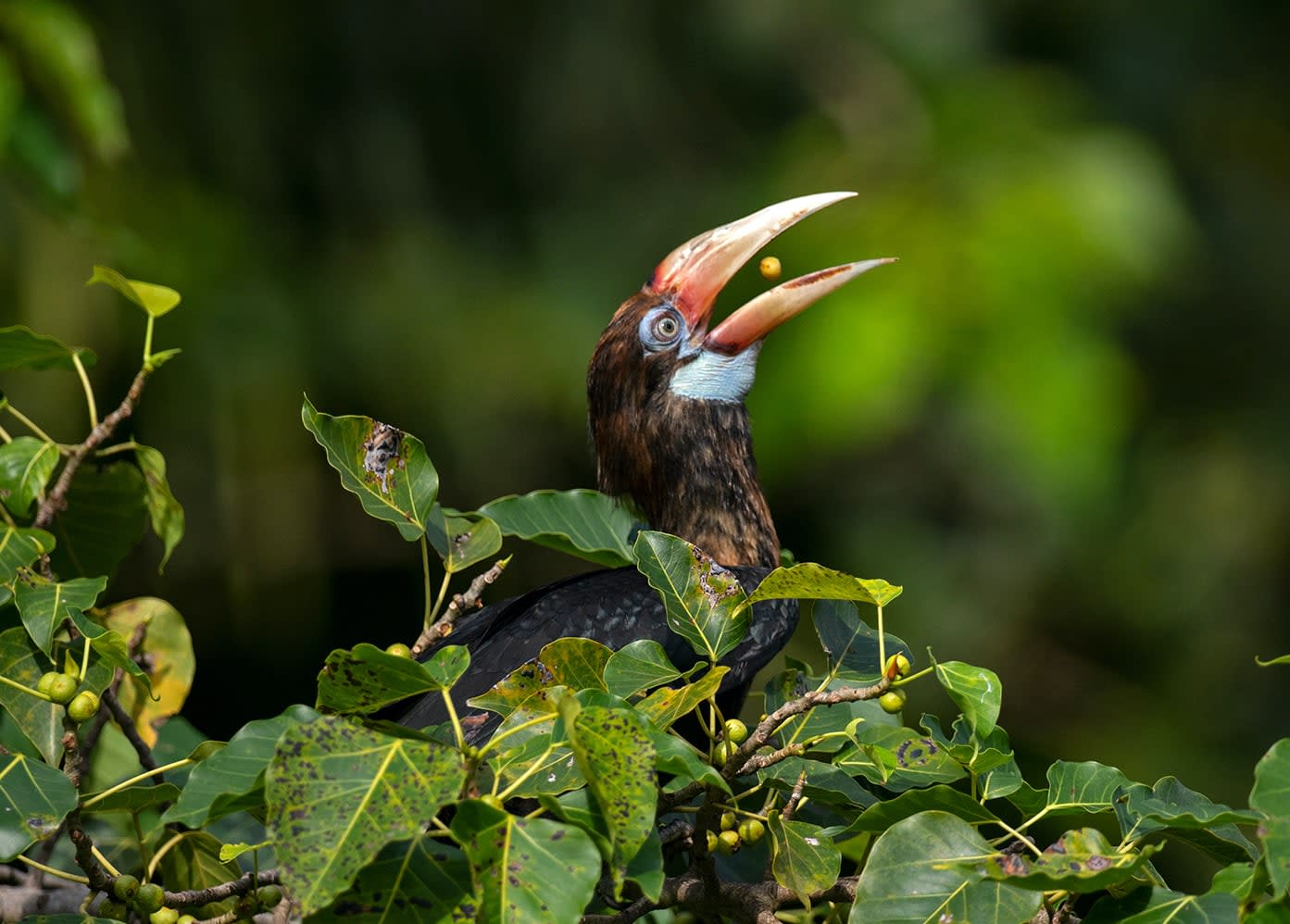 Listen to this article
•
15:34 min
Listen to this article
•
15:34 min
I was part of a research team last winter that – mimicking migratory birds – spent two months on the tropical island of Narcondam. It lies 150 km east of the main Andaman archipelago and is part of the volcanic arc that extends down to Sumatra and Java. Thought to be derived from the Sanskrit for “pit of hell”, its name probably alludes to this volcanic origin.
The most abundant bird on the island is the eponymous Narcondam hornbill. Nowhere else but on this 6.8 square kilometre island is it found; and nowhere else in the world are hornbills found in such high densities.
We watched hornbills to our hearts’ content, but I was equally thrilled to look out for the winter migrants that showed up during our time there; birds that were, like us, outsiders. The lone Nicobar pigeon that hung out around the barracks, the solitary Northern lapwing that showed up one day on the beach and would roost around – and occasionally inside – the temple, or the Daurian starling and the eyebrowed thrushes that fed on figs alongside the hornbills.
Narcondam lies more than 250 kilometres south of the edge of the Irrawaddy delta, and the Burmese coast curves downwards 400 kilometres to its east. Out in the middle of nowhere, it faces the full brunt of the winds as they come raging over the open ocean. Did these birds land up on this tiny island by choice or by chance? Come to think of it, did I know that about any of us, for aren’t all our decisions half chance anyway?
One day, my fellow researcher, Abhishek Gopal, and I were checking camera traps. We were near a Caryota mitis — a kind of fish-tail palm – and Abhishek was downloading the data, when I heard hornbills just up ahead and went to investigate.

Cover: The Narcondam hornbill is found only on a tiny island of the same name in the Andaman archipelago. Figs form a major part of the bird’s diet. Cover photo: Shashank Dalvi
I watched them for a bit before they flew away and just as I was about to turn around, I heard the faintest little sound from the right that made me freeze. It was a tiny mewing sound, that brought to mind a kitten — a kitten in a large, carpeted room. I paid attention and it turned out to be a low chirping, and as I listened, it gently unwound into a low warble.
Close to the ground, in the languid branches of a spreading bush, was the bird. I called Abhishek over and we stood still. The size of a small bushchat, it was plain brown above, pale yellow below. The chin was a creamy off-white, and its chest was mottled in an arc above the pale belly.
It hopped down, walking on long, fair legs, quite comfortable on the ground, hopping up onto rocks and low hanging branches and then back down again, whistling to no one but itself as it went about its business. At times it clicked its beak in a quick twitter to make this rut-tut-tutter sound that was part of its song. The tail didn’t extend too far beyond the wingtips and was constantly bobbing up and down in a quick, fluttering movement.
It moved and we moved our heads with it, to look around leaves and branches as it seemed to wade in the dappled light of the forest floor until it finally disappeared into the undergrowth.
It was a robin. Rohit Naniwadekar, who’s been studying hornbills for 15 years now, is spearheading the project and was with us on the island. He’d managed to get a shaky picture of a robin a few days earlier – a juvenile male with hints of blue on the mantle – from the other side of the island. The bird that Abhishek and I had seen was a female. My first guess was the Indian blue robin (Larvivora brunnea).

The Indian blue robin breeds in the Himalayas and in Eastern China and spends winters in the Western Ghats and in Sri Lanka. They’ve also been seen in the Eastern Ghats, and in Bangladesh and Myanmar — all within the Central–Asian-Indian flyway that tapers down to the Maldives and the British Indian Ocean Territory (BIOT).
But something was off; neither of the birds had any buff or orange on the breast or flanks. Could they be Siberian robins (Larvivora cyane) then? Research shows that the Indian blue robin and the Siberian robin, formerly thought to be thrushes, are actually old-world flycatchers closely allied to the Japanese robins and so they’ve been placed together under the genus Larvivora. The genus now includes six species of which two are endemic to islands in the Japanese archipelago, one is found in mainland China and three are migratory. The Siberian robin has the largest range of them all.
Its summer range extends from Siberia and northern Mongolia, through northeastern China and Korea, to Japan. And though they’ve been reported to stray as far west as Europe, they usually winter in Southeast Asia, going down as far as Indonesia. That’s the East–Asian-Australian flyway, which by-passes most of mainland India.
Narcondam lies at the intersection where the Central–Asian-Indian flyway and the East-Asian-Australian flyway diverge on the way south. We found ourselves in new waters. We were suddenly looking up birds in the first appendix of our guide to the Birds of the Indian Subcontinent – the appendix that listed vagrants.

In the first few days on Narcondam, we’d often be surprised by a drawn out see-saw, that brought to mind the pygmy wren babbler’s call. But as we’d stand still to listen, it would go on into a seen-see-seen… and so on in a never-ending parody. We called it the tsli call and for a long time did not see the bird making the call. Eventually all of us would see the bird and like the blind men with the elephant (or unlike them), we’d come back and discuss our sightings. The picture we got was of a plain, long-browed warbler with a faint wing bar that could easily pass off as a green or greenish warbler (Phylloscopus trochiloides). We, of course, did not get a photograph. Just like Abhishek and I did not get a photograph of the robin.
We’d have to go by sighting and instinct, we thought, and that makes a lot of academic researchers very nervous. We know first-hand the fallibility of the senses. That’s why we rely on objective data and not on anecdotal observations. Then Rohit started going through the footage he’d collected at the hornbill nests and in one of them — a long shot of the male feeding the female at the nest — there was the tsli call in the background, clear as a studio recording. And our friend Shashank Dalvi, whose word on the matter is gospel, confirmed it to be the Arctic warbler (Phylloscopus borealis).
The Arctic warbler breeds throughout the Eurasian taiga, going east into Alaska where it is the only old-world warbler. It winters in Southeast Asia all the way down to East Timor. Its range, shaped like an inverted bell-curve, grazes past the eastern edge of mainland India. It was one of the most commonly heard warblers on Narcondam. It may be a vagrant on the mainland, but on the island, it was very much at home.

Narcondam being an isolated island hosts simpler communities with fewer species than the mainland – limited to the ones that managed to cross the oceanic barrier and then establish a viable population. And yet here were the migrants to whom this was but an annual pilgrimage; the island, probably an integral part of their home range.
I imagine the tiny warbler — no bigger or heavier than my thumb, if my thumb were to sprout wings and a tail — leaving behind the mainland, with water as far as the eye can see, and I wonder at the courage, as vast as the open ocean it had to cross, encompassed within its tiny heart. And to think that it’s done this for aeons, and continues to do this in today’s fractured, broken world. By disregarding borders and repudiating the need to settle down and belong, not only do these birds unify the world that we live in, they also show us another way of life. By taking each day as it comes, they demonstrate a faith that is beyond anything that humans are capable of.
I feel this even more for the robin, than for the warbler; because the warbler I’ve seen flying, sure and strong. But the robin, with its long legs and short wings is a shy understorey bird with a whirring flight. It must be a sight to watch it soar high, with the wind under its wings. And then, after hours – or days – of flying over the unbroken, unrelenting seas it looks down and there, like an uncut gem placed upon the undulating fabric of the ocean, lies Narcondam.
Had it come to the island all the way from the far north, or was it a vagrant Indian blue robin from the Himalayas? I thought I’d never know for sure. Then a few days back, Abhishek, who’d been going through the camera trap data, sent me a picture of the robin. Shashank confirmed it to be a female Siberian blue robin. The bird had strayed over to our camera trap and gotten itself photographed!
The work on Narcondam Island is part of a collaborative project that was undertaken with the support of the Andaman and Nicobar Forest Department, the Special Armed Police (SAP) and the Coast Guard.






